Top News
August 11, 2020 Ryukyu Shimpo
A meeting of the Liberal Democratic Party National Defense Parliamentary Group saw many participants put forth the idea that the Self-Defense Forces should be allowed to use Shimojishima Airport in Miyakojima City for the purpose of strengthening defense of the Nansei Islands. This argument contravenes a memorandum of understanding executed between the national government and the Okinawa Prefectural Government prohibiting military use of Shimojishima Airport. It further throws cold water on the efforts of locals and others who have worked hard to promote regional development through civilian use of the airport. We cannot accept this.
In 1971, before Okinawa was returned to Japan, the Government of the Ryukyu Islands at the time executed with the Japanese government a memorandum of understanding (MOU) called the “Yara MOU” specifying that only civilian aircraft would use Shimojishima Airport, which opened as a pilot training airport. The MOU stipulated that: (1) the Government of the Ryukyu Islands (subsequently the Okinawa Prefectural Government) shall own and manage the airport, and the airport’s mode of use shall be determined by the Government of the Ryukyu Islands; and (2) the Japanese government has no intent to use the airport for any purpose other than civilian flight training and civilian flights, and has no basis under the law to order any use other than such use.
In a note called the “Nishime Confirmation Letter” exchanged between the Okinawa Prefectural Government and the Japanese national government in 1979, the two parties reaffirmed that the airport “shall be available for use by civilian aircraft except in cases of unavoidable circumstances” such as cases of saving lives or times of emergency evacuation. In February 2013, the Abe administration passed a cabinet resolution on a written response specifying that the authority to use the airport “lies in the Okinawa Prefectural Government, which is the manager” of the airport.
Nonetheless, at this meeting of the Liberal Democratic Party National Defense Parliamentary Group, the view was expressed that in light of recent increased activity of Chinese government ships near the Senkaku Islands, the Self-Defense Forces should be allowed to operate on Shimoji Island, given that “the only airport that Self-Defense Force fighter planes can use is in Naha” and Shimoji Island “is close to the Senkakus.”
Defense Minister Taro Kono refuted these arguments, saying, “At this point in time, there is no plan for the Self-Defense Forces to use [the island] for facility-related purposes.” We strongly hope that the government will stand by its promise.
Amidst divided public opinion, the government has been hurrying to deploy the Ground Self-Defense Forces to the Nansei Islands, starting with the deployment of a Coast Observation Unit to Yonaguni in 2016. Missile units and security units have been deployed in Amami and Miyako, and are planned to be deployed in Ishigaki as well. The government’s main concern is China’s increasing military power, but Chinese planes and vessels are increasing their activity to match the accelerating Self-Defense Force deployment. It is apparent that the reinforcement of Self-Defense Force presence is only increasing tensions.
As U.S.-China relations worsen, the United States even has a plan to deploy a new intermediate-range missile system capable of carrying nuclear missiles to the Nansei Islands. We cannot concede to Okinawa, which already hosts more than its share of bases, shouldering any further risk in a contingency. The same is true of Self-Defense Force use of Shimoji Island.
Shimojishima Airport, which has a 3,000-meter runway, has always been targeted each time the topic of military airport use comes up. The airport has experienced ups and downs, dealing with suspension of the flight route that passed through it and cancellation of pilot training there, but in March of last year it reopened as hub for LLCs connecting the island to other parts of Japan and abroad, and it is experiencing a new takeoff as an important piece of infrastructure supporting regional revitalization and livelihoods.
Miyakojima has experienced a surge in tourism in recent years, with 400,000 tourists in fiscal 2013 rising to 1.14 million in fiscal 2018. Though the Covid-19 pandemic presents uncertainty for the future, the Okinawa Prefectural Government hopes to raise the number of tourists to 1.6 million in fiscal 2024. There is no doubt that expanded civilian use of Shimojishima Airport is essential to tourism and economic development.
(English translation by T&CT and Sandi Aritza)
Go to Japanese
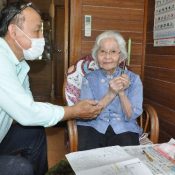
August 4, 2020 Ryukyu Shimpo
By Ryota Nakamura
Recently, the owner of a fountain pen engraved with the name “Eiko Kakazu,” which was discovered in the 24th Division Headquarters trenches in Yoza, Itoman by a member of the group “Okinawa Ari no Kai,” which works on collecting the remains of those who died in the Battle of Okinawa, was found. The owner is Eiko Taira (formerly Kakazu), age 89, who was a student at the Okinawa Prefectural Daini Girls High School at the time her pen was lost. She is from Yoza, where the trenches are located, and still lives nearby. The pen was a gift from her father, Nio Kakazu, to celebrate her passing the high school entrance exam. “It brings me right back to that time,” Eiko said, explaining that the fountain pen brought back memories of her deceased father and her family.
Eiko was born in October 1930 as the youngest daughter of two boys and six girls to her father Nio, who was a doctor in Yoza in what was then Takamine Village (now Itoman City), and her mother Shigeko, who was a midwife. Eiko, who enjoyed history, worked hard at her studies and passed the entrance exam to the Daini Girls High School in 1943. When she did, Nio gave her a fountain pen and pen case to celebrate her passing the exam. Eiko, however, says that she has few memories of ever using the pen. It was too precious to her.
In November 1944, Eiko participated in volunteer activities for the Take Troops (the 9th Division under the 32nd Army). One day, when she was working, her cousin’s cry reverberated: “Your father is in critical condition!” Eiko was in shock and try as she might to rush home, her legs got entangled and it took all she had to make it to her home. “Father, father!” No matter how many times she called to him, Nio did not respond. Eiko had lost her mother Shigeko at 10 years old, and now her father Nio had succumbed to illness. She has photographs of her parents, but hardly any objects of memory remain, and the fountain pen from her father is a precious memento.
The pen and other articles were discovered in the 24th Division Headquarters trenches in early July by Yasuo Minamino, 55, of Naha, who is part of Okinawa Ari no Kai. The Ryukyu Shimpo published a notice to find its owner, and a member of Eiko’s family saw the article and made contact. On July 22, the fountain pen, pen case, and a spatula were returned to Eiko. “It feels unreal. But I’m so overjoyed,” said Eiko, clasping the fountain pen in both hands.
(English translation by T&CT and Sandi Aritza)
Go to Japanese
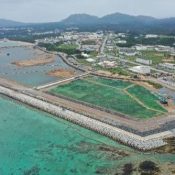
August 7, 2020 Ryukyu Shimpo online edition
On August 7 the Ministry of Defense (MOD) designated 15 U.S. military bases, such as Camp Schwab and Kadena Air Base, as sites subject to the Drone Act, under which the flight of drones is prohibited. This is the first time U.S. military bases have been designated as subject to the Drone Act. There were 14 Self-Defense Force (SDF) sites, such as the Air Self-Defense Force Naha Base, that were additionally designated. It has been made known that the US military bases will be subject to the Drone Act starting on September 6, and the SDF bases will be subject starting on August 17. As such, flying drones within 300 meters surrounding the sites will be principally prohibited, and an agreement will be necessary to do so.
On Camp Schwab in Henoko, Nago City, where construction of the Futenma Replacement Facility (FRF) is moving forward, not only will the land portion be within the scope of prohibition of drone flights, the water area will also be included. Currently, news media and citizens’ groups are flying drones to confirm the status of construction off the coast of Camp Schwab. There is increasing concern about the likelihood that this designation will restrict such activities.
Last year the Drone Act was amended such that “defense-related facilities”, such as U.S. military and SDF facilities, were added as areas subject to drone flight restrictions. This made it such that the MOD was able to principally prohibit the flight of drones over U.S. military bases, water training areas, SDF facilities, and 300 meters therearound. Last year in June and September, the MOD designated, as facilities subject to the Drone Act, government office buildings in Ichigaya, Tokyo and a total of 27 SDF bases. Including the additional designations made on August 7, SDF facilities subject to the Drone Act have reached a total of 41 sites.
After this point the MOD intends to expand the facilities, such as U.S. military bases and SDF facilities, subject to the Drone Act in steps.
(English translation by T&CT and Erin Jones)
◇ ◇ ◇
The defense-related facilities newly designated as no-fly zones for drones are as follows.
[U.S. military sites]
Army: Sahriki Communications Site (Aomori), Camp Zama (Kanagawa), Kyogamisaki Communications Site (Kyoto)
Navy: Atsugi Base (Kanagawa), Yokosuka Base (Kanagawa), Sasebo Naval Base (Nagasaki), Tategami Pier (Nagasaki)
Air Force: Misawa Air Base (Aomori), Yokota Air Base (Kyoto), Kadena Air Base
Marines: Iwakuni Base (Yamaguchi, including water area), Camp Schwab, Camp Hansen (including water area), Camp Foster, Futenma Air Station
[SDF sites]
Ground Self-Defense Forces: Camp Asahikawa (Hokkaido), Camp Obihiro (Hokkaido), Camp Jinmachi (Yamagata), Camp Somagahara (Gunma)
Maritime Self-Defense Forces: Iwakuni Air Station (Yamaguchi), Omura Air Base (Nagasaki)
Air Self-Defense Forces: Chitose Base (Hokkaido), Misawa Base (Aomori), Hyakuri Base (Ibaraki), Hamamatsu Base (Shizuoka), Komatsu Base (Ishikawa), Tsuiki Base (Fukuoka), Nyutabaru Base (Nagasaki), Naha Base
Go to Japanese
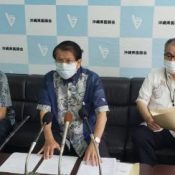
August 7, 2020 Ryukyu Shimpo
The Okinawa Medical Association held a press conference on the morning of August 7 and requested Okinawans residing outside the prefecture to refrain from returning home during the Japanese Bon holiday season this year, which begins on August 13. President Tetsuyoshi Asato also urged Okinawa residents who have family outside the prefecture to refrain from visiting them during the holidays and added, “If you do, I urge you to refrain from meeting with elderly persons.”
The medical association points out that once infected, people aged 60 and above are at higher risk of the novel coronavirus advancing in severity, resulting in death. The association’s Vice President Tatsuya Miyazato advised the public to “Absolutely refrain from meeting with people of advanced age. I know everyone wants to see their families, but I ask that you be patient during this time.”
Governor Denny Tamaki had previously asked Okinawans residing outside the prefecture to refrain from visiting home during Japan’s bon holiday season, asking the public not to “bring infection risks into Okinawa.”
(English translation by T&CT and Monica Shingaki)
Go to Japanese
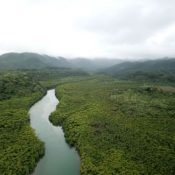
August 7, 2020 Ryukyu Shimpo
Taketomi – The Okinawa Prefectural Office in Yaeyama and the Yaeyama Health Department have disclosed two new confirmed cases of Covid-19 on Iriomote Island in Yaeyama, a boy in his teens and a man in his fifties. The two new cases were not included in the report released by the prefecture on August 6. That same evening Yaeyama announced that the man in his fifties worked at the town government office on the island. There are now a total of three confirmed cases on Iriomote Island.
The two are related to another teenage boy from western Iriomote who as confirmed to have the disease on August 4. On August 5 they started showing symptoms like fever, and after being taken to Yaeyama Hospital on a Japanese Cost Guard ship, were confirmed to have the virus after taking an antigen test. Neither of the cases are being considered serious at this time.
Okinawa Prefecture has asked those who have been infected as well as those who have come in close contact with someone who has been infected quarantine at home, and have asked everyone in Okinawa to refrain from going out except for necessities. The health department has indicated that they will test people believed to have come in contact with the people who have contracted the virus over a wide area based on a tracing survey.
As the island does not have much in the way of healthcare services, there is rising concern that the disease will spread. There are also those who are concerned that this will effect tourism, which was starting to rebound.
Naoyuki Uekame, 64. who operates a hotel in western Iriomote, said, “Because the case was someone who lives here, and not a tourist, I’m worried that it could have spread to a variety of places. Even going to the supermarket has become scary.” There are only two healthcare facilities on the island, one in the eastern part, and one in the west. “There are a lot of elderly people on the island. We can only pray that it doesn’t spread.”
(English translation by T&CT and Sam Grieb)
Go to Japanese
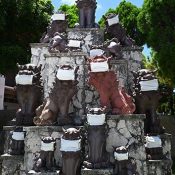
August 6, 2020 Ryukyu Shimpo
Ginowan – At the entrance of Ginowan City Hall on Route 330, fifteen shisa statues, which guard against evil, have donned masks to promote prevention of the spread of the novel coronavirus. The shisa statues wear their masks and watch over the people of the city.
City employees put the handmade masks on the shisa on July 15, hoping to encourage the use of masks. The number of coronavirus cases in Okinawa in growing, leading the prefecture to declare a prefectural state of emergency on July 31. Ginowan government officials have called for citizens to refrain from non-urgent, unnecessary outings, and to bear no bias toward infected individuals.
(English translation by T&CT and Ellen Huntley)
Go to japanese
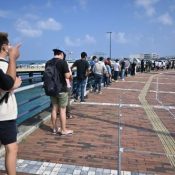
August 2, 2020 Ryukyu Shimpo
On the first day of the prefectural emergency declared by Okinawa August 1, 58 new cases of COVID-19 were confirmed as the spread of the disease shows no signs of slowing down. In Naha, where PCR testing is being conducted, large numbers of people concerned they have contracted the virus are lining up, while the shopping district is deserted on the first weekend of the two week voluntary quarantine. While families could be seen at resorts on the first day of summer vacation, they were all wearing masks, and taking care to observe virus prevention measures.
Never-ending lines of people and cars. “I wonder if I have coronavirus.” On August 1, at testing sites such as the main one in Naha, residents with worried expressions on their faces stood in long lines. Doctors and staff sweat while administering the tests, worried of getting infected themselves.
“We expect a fair number of COVID-positive individuals to come. Please be sure to take sufficient precaution.”
Just before the tests were starting to be administered the morning of August 1, the staff leaned in with serious expressions to listen to the doctors. At the front of the testing site, the line of people waiting for the test was long. The line of cars waiting stretched out in a spiral, and caused traffic congestion on nearby roads.
Naha City has assumed that the testing would be limited to retail workers from the Matsuyama district of the city, which has become a hotspot for the virus. Flyers for the testing were only handed out in that area, however news of the testing spread by word of mouth and people turned out in droves.
One man, 50, from Naha was a regular at a bar in Matsuyama where someone tested positive, and he raced to get tested. He said nervously, “I heard about the PCR testing from the bar staff and came too.” A Nepalese woman, 22, who lives in Naha and works at a steak restaurant on Kokusai-dori came after a co-worker tested positive. Her place of work encouraged her to go and get tested.
A 25-year-old woman who works in a hostess bar came with two children, age four and zero, saying with a dark expression, “The owner of a bar someone I know works at tested positive. I am worried about my kids getting infected.”
Due to the unexpected turnout, testing ended one hour before originally planned, and those who were unable to be tested raised their voices in displeasure.
A self-employed man, 28, who had come in contact with multiple people who tested positive said, “Even though they had a schedule for conducting the tests, I was turned away.” It was also mentioned that the waiting area constructed at the testing site had people waiting for the test sitting in close proximity, to which the man said angrily, “It was the ‘three Cs” (Closed spaces, crowded places, and close-contact settings). Isn’t there a pretty high risk of spreading the disease?
“Our prediction was naïve,” leaked one of the city employees with a worn out expression after administering tests.
(English translation by T&CT and Sam Grieb)
Go to Japanese
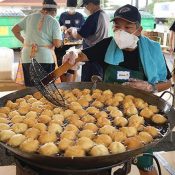
August 3, 2020 Ryukyu Shimpo
By Hanae Gushiken Higa
The Hawaii United Okinawa Association (HUOA) set up a drive-thru for customers to pick up their pre-ordered sata-andagi, a traditional Okinawan treat, at the Hawaii Okinawa Center on July 19. The deep-fried Okinawan sweets are popular in Hawaii, and are simply referred to as andagi.
The HUOA began taking andagi pre-orders online on July 6, for a limited quantity (700 dozen, or 8,400 andagi). The andagi sale was advertised via the HUOA newsletter and its Facebook page, and sold out in just three days. As a COVID-19 precaution, the purchased andagi were picked up by customers in a drive-thru. The doughy treats were fried the same day by HUOA’s president-elect and andagi expert, Patrick Miyashiro and other members of HUOA on a volunteer basis.
HUOA members donned their masks and helped guide the customers through the drive-thru and handed off the andagi. HUOA President Lynn Miyahira said, “It was our first time selling andagi online and setting up a drive-thru pick-up, but it all went smoothy. The customers seemed happy.”
Every year, the HUOA organizes many Okinawa-related events, which were all cancelled this year due to the coronavirus pandemic. The Uchinanchu (Okinawan) community of Hawaii was especially shocked by the cancellation of this year’s Okinawan Festival, Hawaii’s largest ethnic festival, which attracts more than 55,000 visitors. The andagi is a staple of the Okinawan Festival, and about 130,000 are sold every year. Since the treat is an important source of income for the association, the cancellation of the festival was a financial blow; the andagi drive-thru was planned to help mitigate some of the lost income.
The HUOA is also vivifying traditional Okinawan culture through “YUNTAKU LIVE,” its talk and music show featuring uchinanchus in Hawaii, streaming every week on YouTube Live. The association is planning a ‘virtual festival’ for September.
The association is aiming for a thousand YouTube subscribers; show your support and subscribe to the HUOA YouTube channel “Hawaii United Okinawa Association” today.
(English translation by T&CT and Monica Shingaki)
Go to Japanese
July 27, 2020 Ryukyu Shimpo
Uruma – The Okinawa Bullfighting Association (Masakazu Koji, President) held a meeting on July 26, where they decided to cancel the “11th All-Okinawa Summer Bullfighting Festival” set to take place at the Ishikawa Dome in Uruma in August. This will be the first time the event has been cancelled. With the continued spread of COVID-19 in Okinawa, local events scheduled to take place in September or October are also being cancelled across the board.
The association had created some guidelines for the event meant to help prevent the spread of the disease, but decided that in the current situation the even would be too difficult to host. The committee members confirmed that they are still working towards having the “114th All Okinawa Fall Bullfighting Festival” scheduled for November.
Association president Koji said, “We will continue to keep an eye on the situation, but for now we will continue to
prepare to host the event following the guidelines.”
(English translation T&CT and Sam Grieb)
Go to Japanese
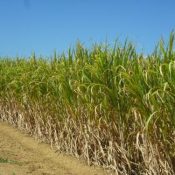
July 30, 2020 Ryukyu Shimpo
Hateruma-jima, an island of Taketomi, has not received any significant amount of rain since June 9. The draught is increasingly affecting sugarcane crops on the island; in addition to leaf rolling—the plant’s mechanism to keep moisture from escaping, some of the ratoons and the summer seed canes are beginning to wilt. There is not sufficient water in the reservoir to water the fields either. An employee of Hateruma Seito, the island’s sugar refinery, expressed concerns over the situation: “We haven’t had a draught like this in about 40 years.”
The Okinawa Meteorological Observatory recorded 101.5 millimeters of rainfall on June 9, but only 6.5 millimeters since. The trend of light rain continued into July, with about 56.5 mm of precipitation for July, as of July 28. It is unlikely that Hateruma-jima will receive the average rainfall this month, which is 126.1 mm. Sugarcane production was expected to reach 11,900 tons this season, but due to the drought, it is likely to stay below 10,000 tons. The sugar refinery employee said, “the spring seed canes did not grow much either. If the draught persists, crop growth will suffer.”
Yonaguni-jima is also facing a light draught. According to the Okinawa Meteorological Observatory, the island received 29.0 mm of rainfall for July as of July 28, which is significantly lower than the average July precipitation of 138.5 mm. Yonaguni-jima planned to produce 4,500 tons of sugarcane this season, but its harvest may be reduced if the draught continues.
According to a representative of the JA Okinawa Sugarcane Promotion Department, the agricultural co-op is deploying tank trucks to water sugarcane fields, as requested by growers.
(English translation by T&CT and Monica Shingaki)
Go to Japanese
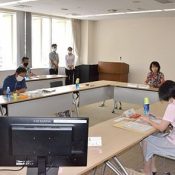
July 29, 2020 Ryukyu Shimpo
A panel of experts called the Universal Shinryo Council on Overseas Networks has been established to listen to the public opinion of Okinawa Governor Denny Tamaki’s ongoing management of the Okinawa prefectural administration. The first meeting of this Council was held on July 28 at the Prefectural Municipality Community Association Hall in Naha City.
The OPG reported that the plan to hold the 7th World Uchinanchu Festival which had been docketed for October 28-31, 2021 no longer has a set period due to the influence of the novel coronavirus, and that once the action committee for the festival has launched it will discuss a timeframe.
The Council discussed resolving problems and assessing prefectural policies for the progression and expansion of an Uchinanchu Network throughout the world, and consolidated a FY2020 proposal document for Governor Tamaki.
There are six members of the Council: Sumiko Ogawa, professor of human health science at Meio University; Makoto Arakaki, head of the humanities department at Okinawa Christian University; Minami Asato, founder and director of the World Youth Uchinanchu Association; Junko Arakaki, representative director of Arakaki Tsusho Corporation and president of the Okinawa Prefecture Foreign Trade Association; Hidehiko Arakaki, director of Kanehide Group and former supervising secretary of public relations interaction for the Office of the Governor; and Keiko Sano, Okinawa office chief representative of the Japan International Cooperation Agency (JICA).
Ogawa was elected head of the Council. Future meetings of the Council will be held in September and November this year, and in February in 2021.
(English translation by T&CT and Erin Jones)
Go to Japanese









 Webcam(Kokusai Street)
Webcam(Kokusai Street)


